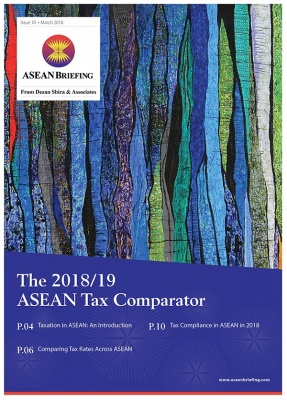
The 2018/19 ASEAN Tax Comparator
Published: March 2018In this issue of ASEAN Briefing magazine, we discuss both the continuity and change in ASEAN’s tax landscape and what it means for foreign investors. We begin by highlighting the salient features of the taxation regimes of the individual member states of ASEAN. We examine the various forms of taxation within ASEAN while highlighting their regional variations. We then provide an inter-country comparison of tax rates, including in relation to PIT, CIT, VAT and GST, which is essential for making informed FDI decisions. Finally, we analyze the ease or burden of tax compliance in ASEAN in 2018 and beyond. We discuss aspects ranging from time and documentation to the effectiveness of government policies for the benefit of would-be investors.
No. of Pages: 13 pages
In this issue:
- Taxation in ASEAN: An Introduction
- Comparing Tax Rates Across ASEAN
- Tax Compliance in ASEAN in 2018
Despite being a close economic grouping, taxation regimes vary across the 10 member states of the Association of Southeast Asian Nations (ASEAN). While there have been moves by ASEAN members to bring their taxation regimes in line with regional integration goals, latent FDI competitiveness has led to the adoption of national strategies that are marked by adjustments in tax rates and formulation of various tax incentive schemes for foreign investors. For overseas investors looking to enter emerging markets in ASEAN, a clear understanding of the various taxes they could potentially be exposed to, remains a key element for early success in one of the world’s most dynamic economic regions.
In this issue of ASEAN Briefing magazine, we discuss both the continuity and change in ASEAN’s tax landscape and what it means for foreign investors. We begin by highlighting the salient features of the taxation regimes of the individual member states of ASEAN. We examine the various forms of taxation within ASEAN while highlighting their regional variations. We then provide an inter-country comparison of tax rates, including in relation to PIT, CIT, VAT and GST, which is essential for making informed FDI decisions. Finally, we analyze the ease or burden of tax compliance in ASEAN in 2018 and beyond. We discuss aspects ranging from time and documentation to the effectiveness of government policies for the benefit of would-be investors.
As ASEAN progresses towards full economic integration, a clear understanding of the intricacies of taxation in the region is key for potential overseas investors. With its proven business intelligence, tax, and market entry knowledge within ASEAN, Dezan Shira & Associates is well positioned to assist companies who are exploring their options in ASEAN, and looking to take advantage of Asia’s most dynamic economic region.

